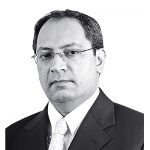Serge Van Herck, CEO of Newtec explains in the first of our series how Ka-band high throughput satellites will transform the business of satellite service providers, teleports and broadcasters. Satellite operators around the world know it: the future of satellite communications is called Ka-band. This is simply because the total capacity offered by other commercial […]

Serge Van Herck, CEO of Newtec explains in the first of our series how Ka-band high throughput satellites will transform the business of satellite service providers, teleports and broadcasters.
Satellite operators around the world know it: the future of satellite communications is called Ka-band. This is simply because the total capacity offered by other commercial frequency bands cannot possibly cope with the ever increasing bandwidth requirements of the cyber world, certainly not at a competitive price against terrestrial services. Relief will not come from the satellite broadcast industry, as new channels, HDTV and soon 3D TV claim increasing shares of the available Ku and C band capacity. In the long run, the only way for satellite operators and satellite services providers to stay in the game is therefore to launch or use new Ka-band satellites. Many launches are now planned around the globe for the coming years and although the main target of these launches is large-scale consumer broadband access networks, the availability of new Ka-band satellites is very likely to have a major impact on the rest of the satellite market, including broadcast and business applications.
Professional VSAT networks
The most obvious business application, after consumer broadband access, is professional and private VSAT networks. Ka-band technology will open the door to very large deployments and therefore the cost of terminals will further go down. The Ka-band satellites also offer higher and cheaper throughput. Because of the gateway-centric star configuration however, it is not possible for a corporation to operate its own hub in its own facilities. Instead, the hub must be hosted in the gateway of the satellite operator. If the network spans across multiple spot beams addressed by different gateways, the network must also include the terrestrial connections among the gateways. Depending on the size of the private network and the type of infrastructure, two different business models can be applied for this kind of application. – The corporate user could operate its own VSAT hub infrastructure, hosted in the gateway of the satellite operator. The hosting services would include the management of the RF part of the hub. The VSAT hub would need to be fully certified by the satellite operator in order to ensure adequate integration in the closed star network configuration and avoid any interference with the functioning of other systems on the same satellite capacity.
The integration and operation of different systems from different vendors on the same spot beam network could therefore prove very challenging. – The satellite operator could have a multi-ISP ground infrastructure. In this case the corporate user can rent a virtual private network on this infrastructure, and manage it as independently as possible from an IP access and user provisioning point of view (the management of the RF part being handled transparently by the satellite operator or service provider). Terrestrial connections among gateways could be part of the virtual network or taken care by the corporate user. This multi-ISP approach requires a higher initial ground infrastructure investment for the satellite or service operator, but a much easier and more flexible way to sell services to professional users of various natures and sizes. From a financial point of view, the investment in a multi-ISP ground infrastructure remains modest compared to the investment in the space segment, while ensuring a quicker return on investment on the total infrastructure.
In conclusion Ka-band satellites are likely to change the circumstances for many different applications, and the companies involved with them enabling new and different business models. Only time will tell how the industry utilises the new applications.
















































































